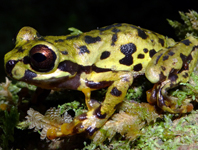Abstract
Aoruroides chubudaigaku n. sp. (Nematoda: Oxyuridomorpha: Thelastomatidae) is described from the wood-burrowing cockroach Panesthia angustipennis spadica (Shiraki, 1906) (Blattodea: Blaberidae: Panesthiinae) from Aichi prefecture, Japan. Females of A. chubudaigaku n. sp. are similar to A. costaricensis Carreno & Tuhela, 2011 by the position of the nerve ring at level of the first third of the isthmus, the body length and the comparative measurements of the oesophagus and tail. They differ by the position of the excretory pore and the vulva. The males of A. chubudaigaku n. sp. are characterized by the absence of ornamentations in the cervical cuticle and the nerve ring located at the posterior third of the corpus. In addition, the males of the new species can be differentiated by the length of the body and the comparative lengths of the oesophagus and the tail. The phylogeny of A. chubudaigaku n. sp. is inferred by the D2-D3 domains of the LSU rDNA and the validity of the genus Aoruroides Travassos & Kloss, 1958 is discussed on the basis of both molecular and morphological data. This constitutes the first species of the genus Aoruroides described from the Japanese archipelago.
References
Adamson, M.L. & Van Waerebeke, D. (1992) Revision of the Thelastomatoidea, Oxyurida of invertebrate hosts I. Thelastomatidae. Systematic Parasitology, 22, 111–130.
https://doi.org/10.1007/BF00009911
Blaxter, M.L., De Ley, P., Garey, J.R., Liu, L.X., Scheldeman, P., Vierstraete, A., Vanfleteren, J.R., Mackey, L.Y., Dorris, M., Frisse, L.M., Vida, J.T. & Thomas, W.K. (1998) A molecular evolutionary framework for the phylum Nematoda. Nature, 392, 71–75.
Capella-Gutiérrez, S., Silla-Martínez, J.M. & Gabaldón, T. (2009) trimAl: a tool for automated alignment trimming in large-scale phylogenetic analyses. Bioinformatics, 25 (15), 1972–1973.
https://doi.org/10.1093/bioinformatics/btp348
Carreno, R.A. & Nadler, S.A. (2003) Phylogenetic analysis of the Metastrongyloidea (Nematoda: Strongylida) inferred from ribosomal RNA gene sequences. Journal of Parasitology, 89, 965–973.
https://doi.org/10.1645/GE-76R
Carreno, R.A. & Tuhela, L. (2011) Thelastomatid Nematodes (Oxyurida: Thelastomatoidea) from the Peppered Cockroach, Archimandrita tesselata (Insecta: Blattaria) in Costa Rica. Comparative Parasitology, 78 (1), 39–55.
https://doi.org/10.1654/4455.1
Chitwood, B.G. & Chitwood, M.B. (1934) Nematodes parasitic in Philippine cockroaches. Philippine Journal of Science, 52, 381–393.
Coy, A., García, N. & Alvarez, M. (1993a) Nemátodos parásitos de diplópodos cubanos con descripción de nueve especies, siete de ellas nuevas. Acta Biológica Venezolana, 14 (3), 33–51.
Coy, A., García, N. & Alvarez, M. (1993b) Nemátodos parásitos de insectos cubanos, Orthoptera (Blattidae y Blaberidae) y Coleoptera (Passalidae y Scarabaeidae). Acta Biológica Venezolana, 14 (3), 53–67.
Darriba, D., Taboada, G.L., Doallo, R. & Posada, D. (2012) jModelTest 2: more models, new heuristics and parallel computing. Nature Methods, 9 (8), 772.
https://doi.org/10.1038/nmeth.2109
García, N. & Coy, A. (1998) Primer registro de nemátodos (Nematoda, Oxyurida, Rhigonematida) parásitos de Amphelictogon sp. (Diplopoda, Polydesmida), para Cuba. Avicennia, 8/9, 41–49.
García, N., Coy, A. & Ventosa, L. (1998) Nuevo género, nueva especie y nuevos registros de thelastomátidos (Oxyurida; Thelastomatidae) parásitos de Byrsotria sp. (Dictyoptera; Blaberidae). Avicennia, 8/9, 50–56.
Guzeeva, E.A., Van Luc, P. & Spiridonov, S.E. (2010) Aoruroides cochinchinensis sp. n. (Oxyurida: Thelastomatidae) from Vietnamese Panesthiinae wood-burrowing cockroaches. Zootaxa, 2477 (1), 62–68.
https://doi.org/10.11646/zootaxa.2477.1.5
Hall, T.A. (1999) BioEdit: a user-friendly biological sequence alignment editor and analysis program for Windows 95/98/NT. Nucleic Acid Symposium Series, 41, 95–98.
Jex, A.R., Cribb, T.H. & Schneider, M.A. (2004) Aoruroides queenslandensis n. sp. (Oxyurida: Thelastomatoidea), a new nematode from Australian Panesthiinae (Blattodea: Blaberidae). Systematic Parasitology, 59, 65–69.
https://doi.org/10.1023/B:SYPA.0000038441.87592.26
Jex, A.R., Hu, M., Rose, H.A., Schneider, M., Cribb, T.H. & Gasser, R.B. (2006) Molecular characterization of Thelastomatoidea (Nematoda: Oxyurida) from cockroaches in Australia. Parasitology, 133, 123–129.
https://doi.org/10.1017/S0031182006009978
Kloss, G.R. (1966) Revisão dos Nematóides de Blattaria do Brasil. Papéis Avulsos do Departamento de Zoologia, São Paulo, 18, 147–188.
Morffe, J. & Hasegawa, K. (2017) Morphological and molecular characterization of Travassosinema claudiae n. sp. (Oxyuridomorpha: Travassosinematidae) from the Japanese millipede Parafontaria laminata (Attems, 1909) (Polydesmida: Xystodesmidae). Zootaxa, 4282 (1), 166–178.
https://doi.org/10.11646/zootaxa.4282.1.10
Morffe, J., Carreno, R.A., Ozawa, S., Sriwati, R. & Hasegawa, K. (2019) On the status of Suifunema peregrinatum (Carreno, 2017) n. comb. (Nematoda: Oxyuridomorpha: Thelastomatidae) and first record of the species for Japan. Zootaxa, 4651 (1), 351–365.
https://doi.org/10.11646/zootaxa.4651.2.9
Nadler, S.A., De Ley, P., Mundo-Ocampo, M., Smythe, A.B., Stock, S.P., Bumbarger, D., Adams, B.J., De Ley, I.T., Holovachov, O. & Baldwin, J.G. (2006) Phylogeny of Cephalobina (Nematoda): molecular evidence for recurrent evolution of probolae and incongruence with traditional classifications. Molecular Phylogenetics and Evolution, 40, 696–711.
https://doi.org/10.1016/j.ympev.2006.04.005
Nunn, G.B. (1992) Nematode molecular evolution. Ph.D. University of Nottingham, Nottingham, 187 pp.
Ozawa, S., Morffe, J., Vicente, C.S.L., Ikeda, K., Shinya, R. & Hasegawa, K. (2016) Morphological, molecular and developmental characterization of the thelastomatid nematode Thelastoma bulhoesi (de Magalhães, 1900) (Oxyuridomorpha: Thelastomatidae) parasite of Periplaneta americana (Linnaeus, 1758) (Blattodea: Blattidae) in Japan. Acta Parasitologica, 61 (2), 241–254.
https://doi.org/10.1515/ap-2016-0034
Ozawa, S., Vicente, C.S.L., Sato, K., Yoshiga, T., Kanzaki, N. & Hasegawa, K. (2014) First report of the nematode Leidynema appendiculata from Periplaneta fuliginosa. Acta Parasitologica, 59 (2), 219–228.
https://doi.org/10.2478/s11686-014-0230-6
Rambaut, A., Suchard, M.A., Xie, W. & Drummond, A.J. (2003) Tracer v1.6. Available from: http://beast.bio.ed.ac.uk/Tracer/ (accessed 12 October 2016)
Ronquist, F., Teslenko, M., van der Mark, P., Ayres, D.L., Aaron, D., Höhna, S., Larget, B., Liu, L., Suchard, M.A. & Huelsenbeck, J.P. (2012) MrBayes 3.2: efficient Bayesian phylogenetic inference and model choice across a large model space. Systematic Biology, 61 (3), 539–542.
https://doi.org/10.1093/sysbio/sys029
Seinhorst, J.W. (1959) A rapid method for the transfer of nematodes from fixative to anhydrous glycerin. Nematologica, 4, 67–69.
https://doi.org/10.1163/187529259X00381
Spiridonov, S.E. & Guzeeva, E.A. (2009) Phylogeny of nematodes of the superfamily Thelastomatoidea (Oxyurida) inferred from LSU rDNA sequence. Russian Journal of Nematology, 17, 127–134.
Sriwati, R., Ozawa, S., Morffe, J. & Hasegawa, K. (2016) First record of Hammerschmidtiella diesingi (Hammerschmidt, 1838) (Oxyuridomorpha: Thelastomatidae) parasite of Periplaneta americana (Linnaeus, 1758) (Blattodea: Blattidae) in Japan, morphological and molecular characterization. Acta Parasitologica, 61 (4), 720–728.
https://doi.org/10.1515/ap-2016-0101
Tamura, K., Stecher, G., Peterson, D., Filipski, A. & Kumar, S. (2013) MEGA6: Molecular Evolutionary Genetics Analysis version 6.0. Molecular Biology and Evolution, 30, 2725–2729.

